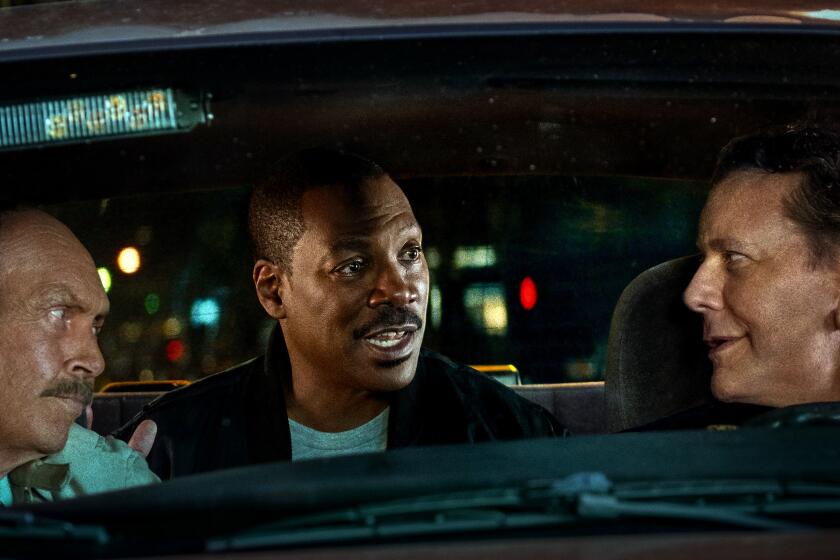Nickelodeon Flexing Muscles
Five years ago, the man who invented MTV assessed his latest assignment, the children’s cable channel Nickelodeon, and what he saw was “spinach.” Video spinach.
It had all the essential video vitamins and nutrients that conscientious parents could feel good about: It had no commercials, no cartoon series with hulking superheroes as stars, lots of nice programs with strong pro-social messages. And, like spinach on a child’s supper plate, it just sat there, barely touched by the young viewers to whom it was served.
So under the direction of MTV guru Bob Pittman, the Nickelodeon team set out to re-create its then-5-year-old children’s channel, casting it in the spirit and and style of MTV. Nickelodeon got hip.
And it worked. If commercial success was the aim, then the reborn Nickelodeon has met, if not surpassed, expectations. Ratings are still minuscule by network standards but have nearly doubled since 1984. Advertisers, now welcomed, avidly associate themselves with Nickelodeon’s numerous sweepstakes for toy-store runs, trips and parties. The channel has grown into a stalwart of basic-cable TV, reaching 46 million subscribers, nearly all homes wired with cable. Last year, net revenues soared to an estimated $90 million, from $59 million the previous year.
Such is Nickelodeon’s success that the talk of it becoming, in the words of one executive, “a worldwide provider of kids’ entertainment” sounds increasingly within reason. Already, Nickelodeon shows are copied in England, Holland and Australia. A mini-Nickelodeon started airing in May in the Philippines. And in something of a departure, a Nickelodeon theme park is in the works--the channel’s first permanent production facilities, which will double as a kid’s attraction, at the New Universal Studios Florida.
But long before there could be any international expansion or studio deals, Nickelodeon had to win over its stubborn constituents--the young members of its audience. “One of the big chal-
lenges was to create an image for the channel that it is the place to be, where the name means something,” says Pittman, now an independent producer, “. . . not as a channel that was good for kids, but for kids.”
As MTV had come to represent teen culture a few years earlier, Nickelodeon set out to define for children a new TV sensibility, distinct from any other. It would be a kind of televised kids’ clubhouse, a world unto itself where children’s styles, language and attitudes prevailed.
The Nickelodeon that emerged would never be mistaken for video spinach. The expressed message of its pitch to young viewers is that this is TV that parents wouldn’t approve of--a TV world where kids get to play with (even wallow in) food, trash a house during a treasure hunt and sound off about bedtimes and emptying the trash.
Symbolic of the change in Nickelodeon, which turned 10 this year, is the phasing out of the last remaining show from the channel’s original schedule, “Pinwheel.” On Sept. 4, “Eureeka’s Castle,” a decidedly more sophisticated show than “Pinwheel,” will make its debut as the centerpiece of the channel’s preschool programming. Where “Pinwheel” was simple and sunny with talking vegetables and fruits imparting positive values, “Eureeka’s Castle” wraps its lessons in a slicker entertainment package of puppets, animation, music and dance revolving around the misadventures of a hapless young sorceress.
Although some parents and educators question aspects of the new Nickelodeon, there is little doubt that the channel, with its kid-hip, us-against-them attitude, has established itself among children.
“You see the kids on Nickelodeon wearing today’s clothing, saying the right things. They’re cool. They’re touching all the right buttons,” says Tom Kinney, a vice president of Bohbot Communications, a media buying agency that specializes in children’s advertising.
Through all this, says Geraldine Laybourne, Nickelodeon’s president, a former schoolteacher who guided the channel through its transformation, “our governing philosophy hasn’t changed at all: We want to provide kids with some fun and diversity.”
Diversity, there is. For 13 hours a day, Nickelodeon presents an eclectic bag of programming--from imported animation (“David the Gnome”) to old network reruns (“Lassie”). (At 8 o’clock, Nickelodeon’s nighttime component, Nick at Nite, takes over with an irreverent presentation of 1950s and ‘60s comedies, which is suitable for the family but is aimed primarily at parents, the members of the original TV generation who were weaned on the shows.)
Increasingly, Nickelodeon is conceiving and producing its own programs, each bearing the distinct imprint of the new Nickelodeon, each carrying the channel a step further from its “spinach” roots. All new Nickelodeon projects share a single aim--entertainment.
“Don’t Just Sit There” is a talk show hosted by teens. “Kids Court,” a show in which the studio audience is judge and jury in debates such as whether a mother should have veto power over a preteen’s hair styles, may incidentally transmit a lesson on trial by peers--but its more obvious appeal is the pitting of a kid against her mom. The newest Nickelodeon production, “Hey Dude,” is a weekly comic adventure series about a group of teen-agers who work at an Arizona dude ranch.
These shows contain the essence of the new Nickelodeon philosophy: “Children have to want to watch the programs,” says Geoffrey Darby, Nickelodeon’s senior vice president for production.
The breakthrough for Nickelodeon, the factor that secured the channel’s finances as well as its trend-setting reputation, was a messy, uninhibited game show for children called “Double Dare,” which became a merchandising phenomenon, inspiring T-shirts, a top-selling home game and a road show, not to mention a whole new genre in kids’ TV.
When “Double Dare” debuted in 1986, it was unlike anything else on children’s television. It combined aspects of “Beat the Clock” and “Jeopardy!,” only for kids, and built up to a show-stopping race through an obstacle course of greased slides, pools of gelatin and mounds of buttered, stale potatoes. Nickelodeon’s ratings for the afternoon time period increased more than 250%, a fact that broadcasters couldn’t help but notice. They wanted “Double Dare,” and eventually the show was sold by executives at Viacom International, which owns Nickelodeon and the other channels in the MTV Networks.
“What it really did for us as a network was get adults to take us seriously,” Laybourne says. “Up to that time, the press hadn’t taken us seriously. Hollywood hadn’t taken us seriously.”
But with a proven hit commodity, the channel now merchandises itself in the form of tennis shoes, Green Slime shampoo, soap and home versions of its game shows.
And MCA Inc., in perhaps the most telling tribute to the power of Nickelodeon’s connection to kids, is building a special Nickelodeon wing at its Universal Florida entertainment and studio complex, scheduled to open next May. That venture will give Nickelodeon its first state-of-the-art production studios, and the Nickelodeon features (such as a “Double Dare” obstacle course) will give Universal a built-in claim on Nickelodeon’s ever-expanding audience base.
It is clear that the quest begun under Pittman has been achieved; the “spinach channel” is now an international programming force. But has Nickelodeon lost its soul along the way? Has the channel’s mission, defined in its beginnings in 1979 as providing kids with television that they can’t find on commercial TV, been subverted by its success?
“I think their programming does connect with kids, not always in the way parents would like it to,” says Ronald Slaby, a developmental psychologist and lecturer on education at Harvard University. “A number of parents I know are concerned about the commercial aspects of the game shows.
“I think one thing they are doing right is offering programming that empowers children or involves them. It has children appearing on camera, voting on who should be president, calling in. To some extent, it is allowing kids to take ownership of a station. Of course, it’s an illusory ownership, but it shows respect for kids.
“Now part of this is for commercial reasons. But it’s offering them something other stations don’t.”
Peggy Charren, president of the consumer group Action for Children’s Television, says Nickelodeon has arrived at a critical juncture in its evolution, where the channel’s profit motive might overwhelm the mandate to serve children.
“You can see where the need to maximize profits is getting in the way of programming decisions,” she says. “When you start to make a lot of money from products, you’re going to pick programs that give you licensing opportunities.” As an example, she cites the decision to follow the success of “Double Dare” with the creation of another game show rather than some other, new type of program.
For her part, Laybourne says she is just exercising good business sense that ultimately will benefit children. In the past, she says, children’s TV has been left to whim because it offered broadcasters few financial incentives to carry it. “The stronger our business, the stronger our library, the richer a kid’s life will be.”
More to Read
The biggest entertainment stories
Get our big stories about Hollywood, film, television, music, arts, culture and more right in your inbox as soon as they publish.
You may occasionally receive promotional content from the Los Angeles Times.






